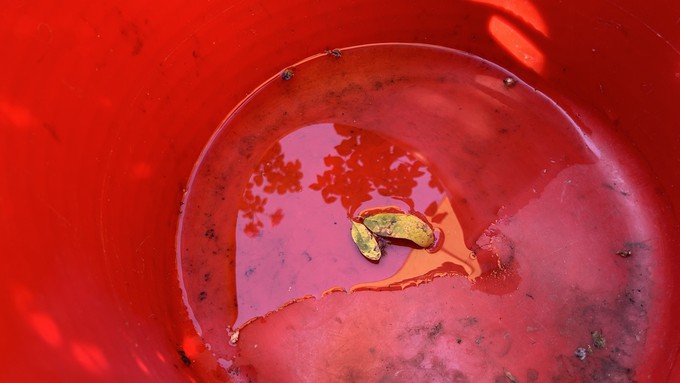
Tuesday's rain gets new water year off to good start

Tuesday night's rain left reminders behind. We might get more rain next week. In the meantime, dump accumulated rainwater from buckets and plant saucers to prevent mosquitos from breeding there. Kathy Morrison
The answer: A firm maybe.
A refreshing break after last weekend’s 90-degree weather, the rain wasn’t a lot, but it was a start. Sacramento recorded 0.15 inches on Tuesday, almost as much as we get in most Octobers, says the National Weather Service. Next Monday, the weather service predicts a 35% chance of more light rain.
Historically, October in Sacramento averages 0.18 inches for the entire month.
We’re coming off a whopper of a water year. Stretching from Oct. 1 to Sept. 30, our water year is a snapshot of our region’s rain and snow totals. The 2022-23 water year totaled 26.22 inches in Downtown Sacramento; that’s 7.02 inches more than Sacramento’s average for the past 30 years – 36.5% above normal.
Just as important for our water picture, the Sierra also had a bountiful water year. Blue Canyon, for example, recorded 92.09 inches of precipitation, way up from its average of 62.44.
Prospects of another wet winter are good. Warm water in the Pacific Ocean likely will fuel an El Niño weather system. El Niño systems typically soak California in mid to late winter.
But not always; some El Niño winters deliver a lot of storms to Southern California but not necessarily that much rain north of Fresno.
To be on the safe side, Sacramento-area gardeners and farmers should be prepared for more wet and cold conditions this winter. Dig up bulbs and tubers that could rot if left in the ground. Have frost protection ready to go early for tender plants. Don’t expect Christmas tomatoes; a cold November could prevent ripening.
According to the Old Farmer’s Almanac, the Central Valley can expect another wet winter plus some chilly nights. But most of our rain will arrive after the New Year.
“A strong El Niño means winter will be wetter than normal, with above-normal mountain snow,” the Almanac says in its 2023-24 winter forecast. “The stormiest, wettest periods will be in early and late January, early to mid-February, and mid-March. There will be a white Christmas across the Sierra Nevada mountains, but not in the valleys or along the coast.”
Expect some frost, too, maybe before Thanksgiving.
“Winter will be colder than normal throughout the region,” the Almanac predicted. “The coldest temperatures will occur in early and late November, early and late December, and late January.”
For more on Sacramento weather: https://www.weather.gov/sto/
Comments
0 comments have been posted.Sacramento Digs Gardening to your inbox.
Food in My Back Yard Series
May 6: Maintain soil moisture with mulch for garden success
April 29: What's (already) wrong with my tomato plants?
April 22: Should you stock up on fertilizer? (Yes!)
April 15: Grow culinary herbs in containers
April 8: When to plant summer vegetables
April 1: Don't be fooled by these garden myths
March 25: Fertilizer tips: How to 'feed' your vegetables for healthy growth
March 18: Time to give vegetable seedlings some more space
March 11: Ways to win the fight against weeds
March 4: Potatoes from the garden
Feb. 25: Plant a fruit tree now -- for later
Feb. 18: How to squeeze more food into less space
Feb. 11: When to plant? Consider staggering your transplants
Feb. 4: Starting in seed starting
Sites We Like
Garden Checklist for week of May 4
Enjoy this spring weather – and get gardening!
* Plant, plant, plant! It’s prime planting season in the Sacramento area. Time to set out those tomato transplants along with peppers and eggplants. Pinch off any flowers on new transplants to make them concentrate on establishing roots instead of setting premature fruit.
* Direct-seed melons, cucumbers, summer squash, corn, radishes, pumpkins and annual herbs such as basil.
* Harvest cabbage, lettuce, peas and green onions.
* In the flower garden, direct-seed sunflowers, cosmos, salvia, zinnias, marigolds, celosia and asters. (You also can transplant seedlings for many of the same flowers.)
* Plant dahlia tubers. Other perennials to set out include verbena, coreopsis, coneflower and astilbe.
* Transplant petunias, marigolds and perennial flowers such as astilbe, columbine, coneflowers, coreopsis, dahlias, rudbeckia and verbena.
* Keep an eye out for slugs, snails, earwigs and aphids that want to dine on tender new growth.
* Feed summer bloomers with a balanced fertilizer.
* For continued bloom, cut off spent flowers on roses as well as other flowering plants.
* Add mulch to the garden to maintain moisture. Mulch also cuts down on weeds. But don’t let it mound around the stems or trunks of trees or shrubs. Leave about a 6-inch to 1-foot circle to avoid crown rot or other problems.